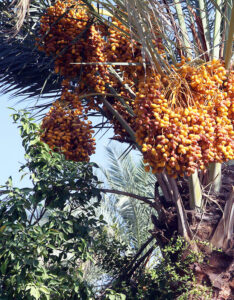Rabbi date is a type of date fruit that is grown primarily in Iran. It is a medium-sized date with a dark brown to black color and a soft, chewy texture. The fruit is known for its rich flavor, which is sweet and slightly nutty.
The Rabbi date is a popular variety of date, and is often used in traditional Middle Eastern cooking. It is also eaten as a snack, and is sometimes used to sweeten tea or coffee.
Like other types of dates, Rabbi dates are a rich source of vitamins, minerals, and fiber. They are particularly high in potassium, which is important for maintaining healthy blood pressure and heart function. They are also a good source of antioxidants, which can help to protect against cellular damage and inflammation.
Overall, Rabbi dates are a delicious and nutritious fruit that is enjoyed by people around the world. Whether eaten fresh or dried, they provide a range of health benefits and are a tasty addition to any diet.
The Geography of Rabbi Dates
Rabbi dates are a type of date that is primarily grown in Saudi Arabia, but they are also cultivated in some regions of Iran, including Sistan and Baluchestan province. Sistan and Baluchestan is located in the southeastern part of Iran, near the border with Pakistan. The climate in this region is hot and arid, with low rainfall and high temperatures throughout the year.
The geography of Rabbi date production in Iran is closely tied to the region's natural resources and climate conditions. Date palms are grown along the banks of rivers and streams, where the soil is fertile and water is available for irrigation. The region's unique climate and soil conditions contribute to the flavor and quality of the dates produced there.
Rabbi dates from Sistan and Baluchestan are known for their rich, sweet flavor and soft, chewy texture. They are typically harvested in late summer and early fall, and are an important source of income for farmers in the region. The production of Rabbi dates in Iran is relatively small compared to other date varieties, but they are highly valued for their flavor and nutritional properties.
In addition to Sistan and Baluchestan, Rabbi dates are also grown in some other regions of Iran, including Kerman province. Kerman is located in the southeast of Iran and is known for its production of high-quality dates, including Mazafati and Shahani dates. The region's hot and dry climate is ideal for date cultivation, and the soil is rich in minerals and nutrients.
Overall, the geography of Rabbi date production in Iran is closely tied to the country's natural resources and climate conditions. The hot and arid climates of regions like Sistan and Baluchestan and Kerman are ideal for date cultivation, and the fertile soils and abundant water sources contribute to the flavor and quality of the dates produced there. Despite being a relatively small producer of Rabbi dates, Iran is known for its high-quality date varieties and is an important player in the global date market.
Properties of Rabbi Dates
Rabbi dates have a distinct shape and appearance that sets them apart from other types of dates. Here are some of the key properties of Rabbi dates in terms of their shape and appearance:
1. Medium-sized: Rabbi dates are typically medium-sized, with an average length of around 2-3 centimeters.
2. Oblong shape: Rabbi dates have an oblong shape, with a slightly curved and pointed end.
3. Dark color: Rabbi dates have a dark brown to black color, which is characteristic of their variety.
4. Soft texture: Rabbi dates have a soft, chewy texture that is similar to other types of dates.
5. Sweet flavor: Rabbi dates have a rich, sweet flavor with a slightly nutty undertone.
In terms of their nutritional properties, Rabbi dates are likely to be similar to other types of dates.
Harvesting Season of Rabbi Dates
The harvesting season for Rabbi dates typically falls between late August and early September, depending on the region and climate conditions. In Iran, where most Rabbi dates are grown, the harvest season usually begins in late August and lasts for several weeks. However, the timing of the harvest can vary depending on the region and climate conditions.
During the harvest season, farmers carefully inspect the date palms to determine the ripeness of the fruit. Rabbi dates are typically harvested when they are fully ripe and have turned a deep brown to black color. The dates are harvested by hand, either by climbing the trees or using ladders to reach the fruit.
After the dates are harvested, they are sorted and cleaned to remove any debris or damaged fruit. They are then packaged and shipped to markets and consumers around the world.
Overall, the harvest season for Rabbi dates is relatively short, lasting only a few weeks. During this time, farmers work tirelessly to harvest and process the fruit, ensuring that it is of the highest quality and ready for market.
Sorting Of Rabbi Dates
Sorting of Rabbi dates is an important step in the post-harvest process, which involves separating the good quality dates from the damaged or inferior ones. The sorting process helps to ensure that only high-quality dates reach the market and consumers, which is important for maintaining the reputation and profitability of the date industry.
The first step in the sorting process is to remove any debris, such as leaves, stems, and twigs, that may have become mixed in with the dates during harvesting. This is typically done by hand or using a machine that shakes the dates to remove any unwanted material.
Next, the dates are sorted based on their size, shape, and quality. This is typically done using a grading machine, which separates the dates into different categories based on their characteristics. Dates that are too small or damaged are usually discarded or used for other purposes, such as making date paste or syrup.
After the initial sorting, the dates are inspected by hand to ensure that they meet the desired quality standards. This involves checking for defects such as mold, insect damage, or discoloration, which can affect the flavor and texture of the dates.
Once the sorting process is complete, the dates are packaged and labeled according to their quality and grade. This information is important for buyers and consumers, who use it to make informed purchasing decisions.
Overall, the sorting process is a critical step in the production of high-quality Rabbi dates. By carefully inspecting and grading the fruit, farmers and processors can ensure that only the best dates are sold to customers, helping to maintain the reputation of the date industry and ensuring the profitability of their business.
Packaging of Rabbi Dates
Packaging of Rabbi dates is a crucial step in the post-harvest process, as it helps to preserve the quality and freshness of the fruit and ensures that it reaches consumers in good condition. There are several factors to consider when packaging Rabbi dates, including the type of packaging material, the size and weight of the packages, and the labeling and branding of the product.
The most common packaging materials for Rabbi dates are plastic or cardboard boxes, which are sturdy and can protect the fruit from damage during transport and storage. The boxes are typically lined with a layer of plastic or paper to prevent the dates from sticking together and to absorb any excess moisture.
The size and weight of the packages can vary depending on the intended market and customer preferences. For example, smaller packages may be more suitable for retail sales, while larger packages may be better for wholesale or export markets.
Labeling and branding of the product are also important considerations in the packaging process. The packaging should clearly indicate the origin, variety, and quality of the dates, as well as any relevant information such as nutritional content or storage instructions. The packaging may also include branding or logos to help distinguish the product from competitors and build brand recognition.
In addition to packaging, proper storage and transportation are also important factors in preserving the quality of Rabbi dates. The fruit should be stored in a cool, dry place to prevent spoilage, and transported using appropriate methods such as refrigerated trucks or containers.
Overall, packaging of Rabbi dates is a critical step in ensuring the quality and freshness of the fruit and maintaining the profitability and reputation of the date industry. By carefully selecting the right packaging materials, sizes, and branding, farmers and processors can successfully market their product to a wide range of customers and markets.
Transporting of Rabbi Dates
Transporting of Rabbi dates is an important step in the post-harvest process, as it involves moving the fruit from the farm or processing facility to markets and consumers around the world. There are several factors to consider when transporting Rabbi dates, including the mode of transportation, the packaging and storage of the fruit, and the distance and duration of the journey.
The most common mode of transportation for Rabbi dates is by truck or ship, depending on the distance and destination of the shipment. For shorter distances, trucks are typically used to transport the fruit, while for longer distances, ships are used to transport the fruit in refrigerated containers.
The packaging and storage of the fruit are also important considerations in transporting Rabbi dates. The fruit should be packaged in sturdy, protective containers such as cardboard or plastic boxes, which are lined with a layer of plastic or paper to prevent the dates from sticking together. The fruit should also be stored in a cool, dry place to prevent spoilage and maintain its quality and freshness.
During transportation, the fruit should be carefully monitored to ensure that it remains at the appropriate temperature and humidity levels. This is particularly important for long-distance shipments, where the fruit may be in transit for several days or even weeks. Refrigerated trucks and containers are typically used to maintain the desired temperature and humidity levels during transport.
In addition to packaging and storage, proper documentation and labeling are also important factors in transporting Rabbi dates. The shipment should be accompanied by the appropriate documentation, including export and import permits, certificates of origin, and shipping invoices. The packaging should also be labeled with the origin, variety, and quality of the dates, as well as any relevant information such as nutritional content or storage instructions.
Overall, transporting of Rabbi dates is a critical step in the post-harvest process, as it helps to ensure that the fruit reaches markets and consumers around the world in good condition and maintains its quality and freshness. By carefully selecting the right mode of transportation, packaging, storage, and labeling, farmers and processors can successfully market their product to a wide range of customers and markets.

